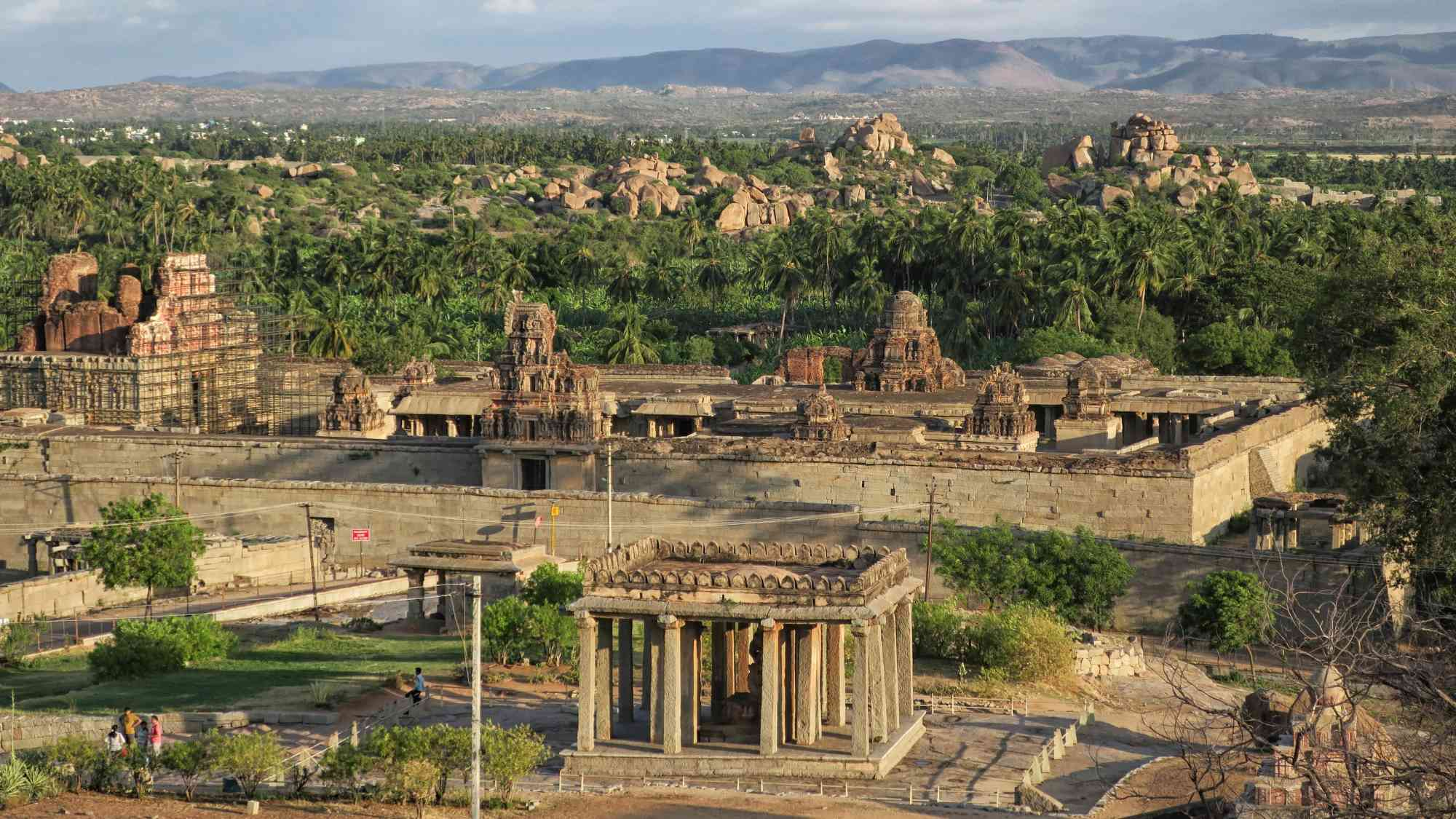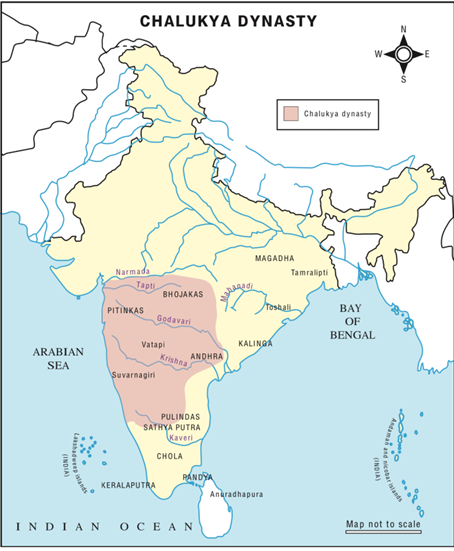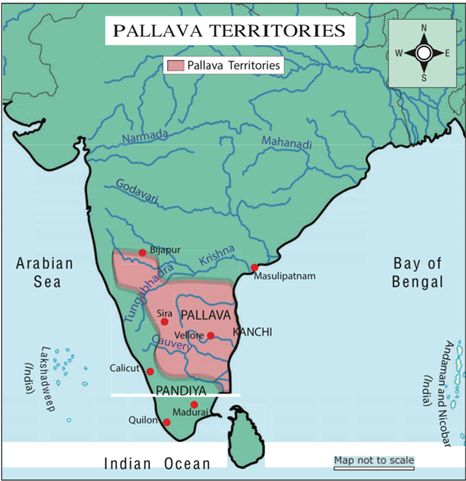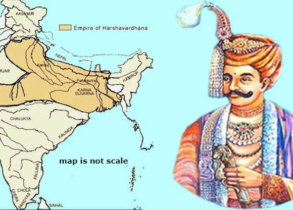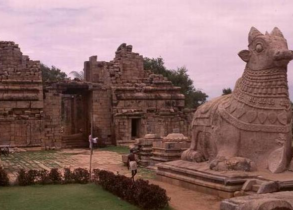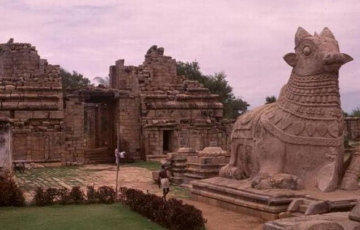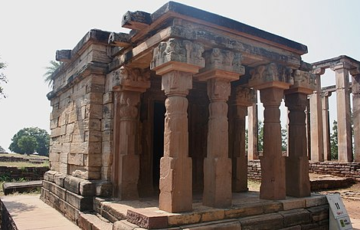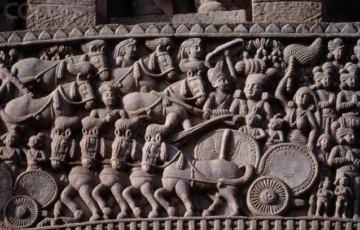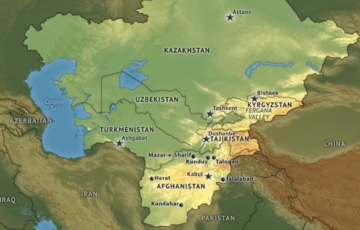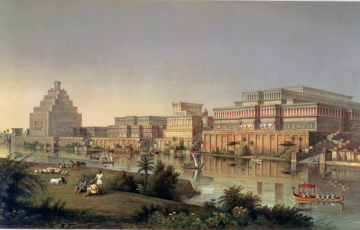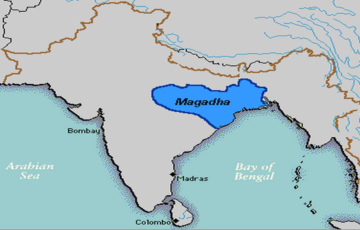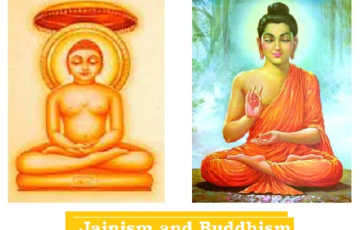KINGDOMS OF SOUTH
Introduction
South India witnessed intense conflict between the Chalukyas of Badami and the Pallavas of Kanchi from the 6th to 9th centuries AD. Despite the conflicts, this period saw remarkable advancements in culture, literature, and various art forms in the region.
CHALUKYAS
Sources to Study
- Inscriptions: The inscriptions on the Allahabad Pillar attributed to Samudragupta and the Aihole inscription associated with Pulikesin II offer insights into the Pallava-Chalukya confrontation.
- Literature:
- The accounts of Arab travelers and geographers such as Sulaiman, Al-Masudi, and Ibn Hauka offer insights into India’s socio-political and economic landscapes.
- Kannada literary works like Kavirajamarga and Vikramarjuna-vijayam (also known as Pampabharata by Pampa).
- Nannaya’s Mahabharatam in Telugu.
- Poems:
- Thevaram, authored by Appar (Thirunavukkarasar), Sambandar (Thirugnanasambandar), and Sundarar; along with Thiruvavasagam by Manickavasagar.
- The Vaishnavite Azhwars’ poetry, eventually compiled as the Nalayira Divya Prabhandam.
- Saiva literature, revered as the Panniru Tirumurai.
Important Rulers
| Pulikesin I (543-566 AD) | ● Established the Chalukya dynasty by proclaiming independence from the Kadambas.
● He demonstrated proficiency in Manu-sastra, Puranas, and Itihasas. ● Conducted the Ashwamedha yagna. |
| Kirtivarman (566-597 AD) | ● Founded the capital city of Badami. |
| Pulikesin II (609-642 AD) | ● Defeated Mangalesha and ascended the throne, as described in the Aihole inscription.
● Emerged victorious against Harshavardhana near the Narmada River. ○ He then adopted the title of Parameswaran. ● Consolidated authority over regions including Malwa, Kalinga, and the eastern Deccan. ● Conquered the Kadambas of Banavasi and the Gangas of Talakad (Mysore). ● Engaged in a prolonged conflict with the Pallavas after an unsuccessful attempt to invade Kanchipuram, led by Pallava ruler Mahendravarman. ● Met his demise in battle against Pallava King Narasimha Varman I. ● During the middle of the eighth century, the Rashtrakutas subdued the Badami Chalukyas, thereby replacing them as the dominant power in the region. |
Administration
| Kingship | ● The king held the highest authority in the administration.
○ Primogeniture, the succession by the eldest son, was not strictly adhered to. Instead, the eldest son was appointed as Yuvaraja while the king was still reigning. ● Governance was guided by principles from Dharma-sastra and Nitisastra. ● Initially, titles like Maharajan, Sathyasrayan, and Sri-Pritivi-Vallaban were assumed by the rulers. Afterwards, Kings assumed titles like Maharajadhiraja, Dharma Maharaja, and Bhattarakan. ● The royal insignia was the wild boar, representing the Varaha avatar of Vishnu. |
| State | For administrative purposes, the state was politically divided into Vishayam, Rastram, Nadu, and Grama. |
| Ministers Categories | ● Pradhana: The head minister overseeing overall governance.
● Mahasandhi-Vigrahika: Responsible for foreign affairs and diplomatic relations. ● Amatya: Held the position of revenue minister, managing financial matters. ● Samaharta: Oversaw the treasury and financial administration. ● Grampohis and Gramkudas: Village officials tasked with local governance. ● Nala-kavundas: Traditional revenue officials responsible for revenue collection in villages. ● Kamunda or Pokigan: Central figures in village administration appointed by the kings. ● Mahapurush: Maintaining order and peace within the village. ● Maha-Samanta: Provincial governors, some of whom commanded troops. ● Mahajanam: Responsible for upholding law and order within the village. ● Mahatras: Prominent members of the village community. ● Nagarapatis or Purapatis: Officials overseeing town administration. ● Vishayapati: Chiefs of districts known as “Vishaya” who wielded authority under the king’s direction ● Karana or Gramani: Village accountants. |
| Women | ● Jayasimhan I’s lineage were appointed as provincial governors.
● They were granted the authority to issue coins and inscriptions. ● For instance, Vijya Bhattariga, a Chalukyan princess, issued inscriptions during this period. |
Religion
- They were patrons of both Saivism and Vaishnavism, supporting temples and religious activities associated with both traditions.
- Brahmin groups from the Gangetic regions were invited to conduct rituals and ceremonies in temples.
- Notable rulers like Kirtivarman, Mangalesa, and Pulikesin II conducted yagnas (sacrificial rituals). Titles such as Parama-Vaishnava and Parama-Maheswara were conferred upon them.
- They accorded importance to Kartikeyan, the war god, and Saiva monasteries served as centers for promoting Saivism.
- Heterodox sects like Jainism were also patronized, with donations of land and support.
- Ravikirti, the poet-laureate of Pulakesin II, was a Jain scholar.
- Kirtivarman II oversaw the construction of a Jain temple in Annigere during his reign.
- Prince Krishna appointed Gunapatra, a Jain monk, as his mentor.
- Pujyapatar, the author of JainentriyaViyakarnam, was a contemporary Jain monk during the rule of Chalukyan ruler
- Hiuen Tsang noted the existence of numerous Buddhist centers, with followers of both Hinayana and Mahayana sects residing there.
Literature
- Sanskrit was used in pillar inscriptions such as those found at Aihole and
- A seventh-century inscription acknowledges Kannada as the local language and Sanskrit as the language of culture.
- A chieftain of Pulikesin II authored a Sanskrit grammar work called
- The Aihole Inscription of Pulakesin II, located in the Megudi Jain temple in Aihole, Karnataka, dates back to 635 AD and was composed by the poet Ravikriti.
- This inscription serves as a Prashasti, extolling the achievements of the Chalukya dynasty, with a particular focus on King Pulikesin II, also known as Sathyasraya (the abode of truth).
- It provides a historical account of the dynasty’s victories, including the notable triumph over Harshavardhana.
Architecture
- The Chalukyas introduced the innovative technique of constructing temples using soft sandstones.
- Their temple architecture is categorized into two main types: Excavated cave temples and Structural temples.
- Badami is renowned for both types of temples, featuring four caves, with the largest one dedicated to Vishnu and built by Mangalesa.
- Pattadakal, exemplified by the Virupaksha temple, and Aihole, known for the Lad Khan temple, are famous for their structural temples.
- In Pattadakal, the Chalukyas erected more than ten temples, showcasing the evolution of Chalukya architectural styles.
Paintings
- The Chalukyas embraced the Vakataka style of painting in their artistic endeavors.
- Numerous paintings within the Chalukya realm depict various incarnations of Vishnu.
- One of the most renowned Chalukya paintings is located in the palace constructed by King Mangalesan (597-609 AD).
- This particular artwork portrays a scene of a royal ball attended by members of the royal family and other dignitaries.
PALLAVAS
There exists no definitive consensus among scholars regarding the origin of the Pallavas. Some theories suggest a connection to the Pahlavas, also known as Parthians, while others propose a native origin in South India, possibly with some northern Indian ancestry.
- The term “Pallava” is believed to derive from the Sanskrit word “pallava,” meaning “creeper,” akin to the Tamil word “tondi.”
- Initially a pastoral local tribe, the Pallavas established their dominance in the region known as Tondaimandalam, located between the north Pennar and north Vellar rivers.
- This area encompassed southern Andhra Pradesh and northern Tamil Nadu, with their capital situated at Kanchi.
- During their rule, Kanchi, modern-day Kanchipuram, emerged as a significant temple town and a hub of trade and commerce.
Sources to Study
- Buddhist texts such as the Deepavamsa and Mahavamsa, written in Pali, offer insights into the socio-religious and cultural landscape during the Pallava era.
- Accounts from Chinese travelers like Hiuen Tsang and Itsing also provide valuable information about this period.
- Periyapuranam, authored by Sekizhar, and Mathavilasa Prahasanam, composed by Mahendravarman I in Sanskrit, serve as crucial sources for studying the Pallava period.
Important Rulers
| Shivaskandavarman | ● Likely ruled in the early 4th century AD, as indicated by certain inscriptions.
● Referred to as ‘Agnisttomavajapeyasvamedhayaji’ in the Hirahadagalli plates, signifying his participation in significant Vedic sacrifices. |
| Simhavishnu | ● Governed in the late 6th century and played a pivotal role in the ascent of the Pallavas.
● Achieved victories over the Ikshvakus and Kalabhras, expanding Pallava influence up to the Kaveri River. ● Established Kanchi as the capital and held the title of ‘Avanisimha,’ denoting the prowess of a lion. |
| Mahendravarman I (590−630 AD) | ● Suffered defeat against the Chalukyan ruler Pulekshin II, resulting in the annexation of the northern Pallava territories.
● Known for his artistic patronage, being a poet, musician, and supporter of the arts. ● Authored the Mattavilasa Prahasanna and initiated the construction of the cave temple at Mahabalipuram. ● Initially followed Jainism but later embraced Shaivism under the influence of Appar. |
| Narasimhavarman I / Mahamalla (630−668 AD) | ● Triumphed over Pulkeshin II, capturing Badami with the assistance of the Sri Lankan prince Manavarma.
● Secured victories against the Cholas, Cheras, and Kalabhras. ● Notable for his architectural endeavors, including the construction of Mamallapuram port and the Rathas. ● Mahabalipuram is also known as Mamallapuram in his honor. |
| Mahendravarman II (668−670 AD) | ● Faced continued conflict with the Chalukyas and perished in battle against them. |
| Parameshvaraman I (670−695 AD) | ● Known as Ugradanda and credited with defeating the city of Ranarasika, associated with Vikramaditya I.
● His military exploits are documented in the Kuram copper plates. |
| Narasimhavarman II / Rajasimha (700−728 AD) | ● Commissioned the Rajasimheshvara/Kailashnatha Temple and Shore Temple at Mahabalipuram.
● Maintained diplomatic relations by sending an envoy to China. |
| Dantivarman (795−846 AD) | ● Faced invasion by Rashtrakuta king Govind III during his reign. |
| Nandivarman III (846−869 AD) | ● Emerged victorious against the Pandyas in the Battle of Sripurambiyam with the aid of western Gangas and Cholas. |
| Aparajita (880−893 AD) | ● Died in battle against Chola king Aditya I, leading to the decline of the Pallavas. |
Administration
- Kings: The concept of kingship was perceived as of divine descent and inherited through generations. Kings assumed grandiose titles such as Maharajadhiraja, influenced by North Indian traditions.
- Queens: Pallava queens typically did not play active roles in the administration of the kingdom. Instead, they were involved in religious activities such as constructing shrines, installing deity images, and supporting temples through endowments.
- An inscription in the Kailasanatha temple in Kanchipuram features the image of Queen Rangapataka, the consort of Rajasimha.
- Council of Ministers: They governed with the support of a council of ministers, who held significant authority in decision-making.
- Certain ministers held semi-royal titles and might have been selected from the ranks of feudal lords or other influential individuals within the kingdom.
- Amatyas: Counsellors who provided advice and guidance to the king
- Mantrins: Ministers responsible for managing diplomatic relations.
- Rahasyadhikrita: Private secretary who handled confidential matters.
- Manikkappandaram/Kappan: Treasury officer in charge of managing royal finances and accounts.
- Kodukkappillai: Officer responsible for overseeing the distribution of gifts.
- Kosaadhyaksa: Treasury supervisor.
- Judiciary: Judicial courts were referred to as Adhikarna Mandapa.
- Dharmadhikarins served as judges within these judicial courts.
- Fines were specified in the Kasakudi plates of Nandivarman, with distinctions between Karanadandam (fines in superior court) and Adhikaranadandam (fines at the district level).
- District officers closely collaborated with local autonomous institutions and provided counsel to provincial governors.
- Local autonomous bodies were formed based on various social groups such as castes, guilds, and crafts.
- Policy implementation was facilitated through meetings between district representatives and assemblies of villagers.
Land Grants
- Land ownership was centralized in the king, who held the power to grant revenue and land to officials and Brahmins.
- Crown lands were commonly cultivated through tenant farming arrangements.
- Villages with diverse caste populations were required to pay land revenue.
- Brahmadeya villages were bestowed upon individual Brahmins or Brahmin groups, exempting them from taxation and fostering prosperity.
- Devadana villages were gifted to temples, contributing to their wealth and influence.
- Revenue from these villages was directed to temple authorities rather than the state treasury.
- Temple authorities supported villages by offering employment opportunities in temple services.
- Over time, temples became pivotal to rural life, enhancing the importance of devadana villages in the socio-economic landscape.
| At Urrukkattukottam, close to Puducherry, archaeologists unearthed eleven plates bound by a copper ring and imprinted with a seal depicting a bull and a lingam, emblematic of the Pallava dynasty.
● These plates document a village grant sanctioned by King Nandivarman in the year 753 AD. ● The inscription begins with a Sanskrit praise of the king, transitions into Tamil for the specifics of the grant, and concludes with a Sanskrit verse. |
Life in Villages
- The village assembly, known as Sabha, was responsible for managing various village affairs such as land allocation, irrigation, record-keeping, and addressing criminal matters.
- It operated under the authority of the district council, which collaborated with the district administration known as
- Sabha was a formal institution, it closely interacted with the urar, an informal village gathering.
- The village headman acted as a liaison between the village assembly and the official administration.
- Villages predominantly populated by Brahmins maintained meticulous records of Sabha and council proceedings.
- Village courts were also tasked with adjudicating minor criminal cases.
- At a higher administrative level in towns and districts, courts were presided over by government officials, with the king serving as the ultimate arbiter of justice.
Tank Irrigation
- Eripatti, also known as tank land, was a distinct category of land exclusively found in South India.
- This land was donated by individuals, with the revenue generated reserved for the maintenance of the village tank.
- The village tank played a crucial role in storing rainwater for irrigation during prolonged dry periods.
- Constructed with brick or stone lining, the tank was built through collaborative efforts of the village, and its water was shared among all cultivators.
- A special tank committee, appointed by the village, was responsible for overseeing the distribution of irrigation water.
- Water distribution was facilitated through canals equipped with sluices to regulate water levels and prevent overflow at the source.
Revenue and Taxation
- Revenue in the Pallava period primarily originated from rural sources, with urban and mercantile institutions being less organized.
- Detailed information on land revenues and taxation during the Pallava era is provided in copper plate inscriptions documenting land grants.
- Villages were subject to two main taxes:
- Land revenue, paid by cultivators to the state, typically ranges from 1/6th to 1/10th of the produce.
- Local taxes, utilized for village services such as repairing irrigation systems and lighting temples.
- Additional taxes were imposed on various professions and activities, including those related to draught cattle, toddy extraction, pottery, and goldsmithing, especially when state land tax revenues were insufficient.
- War loot also contributed significantly to the state’s revenue, highlighting the significance of warfare in Pallava governance and economy.
Army
- State revenue in the Pallava period was primarily allocated to maintain the standing army, directly controlled by the King.
- The army consisted of foot soldiers, cavalry, and a limited number of elephants.
- Chariots, once prominent, became obsolete and ineffective in the hilly terrains where much of the fighting occurred.
- The cavalry was recognized as effective but incurred substantial costs, particularly due to the need to import horses.
- The Pallavas established a navy and built dockyards at Mamallapuram and However, their naval strength was notably smaller compared to the Cholas.
- Sculptures at the Vaikunta Perumal temple in Kanchipuram depicted significant events from the reign of Nandivarama Pallava, underscoring the importance of warfare in Pallava society.
Trade
- Kanchipuram held significant importance as a bustling trading center during the Pallava period.
- Merchants were required to obtain licenses to trade their goods, indicating a regulated commercial environment.
- Initially, a barter system prevailed, but the Pallavas later introduced gold and silver coins, facilitating monetary transactions.
- Merchant organizations such as Manigramam were established to oversee and regulate trade activities.
- Traders formed guilds, categorizing themselves as Sudesi, Nanadesi, Ainurruvar, and others.
- The primary guild operated in Aihole, facilitating trade and commerce.
- Foreign merchants, known as Nanadesi, had a distinct flag featuring a bull emblem at the center and held the privilege of issuing vira-sasanas.
- Vira-Sasanas were inscriptions authored by guilds, glorifying their courageous and heroic exploits as traders and warriors.
Maritime Trade
- The Pallavas engaged in maritime trade with Southeast Asia, fostering economic ties with the region.
- The jurisdiction of Pallava trade guilds extended over Southeast Asia, with their leaders referred to as Pattanswamy, Pattnakilar, and Dandanayaka in inscriptions, and their members identified as Ayyavole-Parameswariyar.
- Foreign trade activities included exporting commodities such as spices, cotton textiles, precious stones, and medicinal plants to various regions, including Java, Sumatra, Cambodia, Sri Lanka, China, and
- Mamallapuram played a pivotal role as a key seaport facilitating trade with Southeast Asian kingdoms such as Kambuja (Cambodia), Champa (Annam), and Srivijaya (the southern Malaya peninsula and Sumatra).
- On the West Coast, foreign traders, primarily Arabs, gradually dominated trade, with Indian traders transitioning into suppliers of goods rather than carriers.
Society
- The caste system became firm, with Sanskrit gaining high esteem as the language of learning and culture.
- Aryanization and northern influences on the southern region accelerated, as evidenced by the issuance of royal grants by Pallava kings.
- Kanchipuram retained its significance as a major center of education and scholarship.
- Followers of the Vedic religion, particularly devoted to the worship of Shiva, proliferated during this period.
- Renowned Shaiva (Nayanmars) and Vaishnava (Alwars) poet-saints flourished during the reign of Mahendravarman.
- Brahmins experienced an elevation in status, receiving substantial land grants and assuming influential roles as royal advisors in literature, astronomy, law, and various professions.
- Sat-kshatryas, a subgroup within the Kshatriya caste, played a pivotal role in governance, involved in both trade and warfare and holding the privilege of Vedic study.
- Lower strata of society primarily engaged in agricultural, husbandry, and artisanal occupations, while those involved in scavenging, fishing, dry-cleaning, and leather works existed outside the traditional varna system.
Religion
| Jainism | ● Jains initially utilized Sanskrit and Prakrit for their religious texts but eventually transitioned to Tamil.
○ While Jainism enjoyed significant popularity, competition from Hinduism contributed to a decline in Jain followers over time. ● Mahendravarman I’s conversion from Jainism to Saivism resulted in a loss of royal patronage for Jains. He became intolerant towards Jainism and ordered the destruction of Jain monasteries. ● Jains established educational and religious centers near Madurai and Kanchi, as well as notable sites like Shravanabelagola in Karnataka. However, many Jain monks opted for isolation in remote caves within hills and forests. |
| Buddhism | ● Monasteries played a crucial role in the Buddhist educational system, particularly concentrated around areas like Kanchi and the valleys of the Krishna and Godavari rivers.
● Buddhism experienced a decline primarily due to the absence of royal patronage and internal conflicts between orthodox and heterodox sects, which favored proponents of Vedic religions. ● While Buddhism and Jainism witnessed a decline, records from travelers like Hiuen-Tsang indicate the presence of numerous Buddhist monasteries and priests in Kanchi, particularly belonging to the Mahayana school. |
In the eighth century, Mathas gained prominence, serving as multifunctional institutions that combined aspects of a rest house, feeding center, and educational facility.
Art and Architecture
- Mahendravarman I is credited with introducing rock-cut temples in the Pallava territory, characterized by a mandapa type structure. These temples typically feature a pillared hall or mandapa in front and a small shrine located at the rear or sides.
- The Mandagappattu inscription highlights that shrines dedicated to Brahma, Isvara, and Vishnu were constructed without the use of traditional materials such as brick, timber, metal, and mortar, indicating the innovative architectural techniques employed during this period.
- The Kailasanatha temple in Kanchipuram contains an inscription featuring the image of Queen Rangapataka, consort of Rajasimha, underscoring the royal patronage extended to religious and architectural endeavors.
- Initially, the early Pallava rulers issued their charters in Prakrit, but later successors transitioned to issuing charters in Sanskrit, reflecting a shift in administrative practices and cultural influences over time.
Literature
- Sanskrit served as the official language in the royal court, leading to its widespread adoption in literary circles.
- Kanchi boasted a renowned university comparable to Nalanda, alongside several other Sanskrit colleges.
- Mahendravarman I himself composed the Mathavilasa Prahasanam in Sanskrit, showcasing his literary prowess.
- Two exceptional works in Sanskrit literature set the standard for literary excellence in the south: the Kiratarjuniya by Bharavi and the Dashakumaracharita by Dandin.
- Dandin of Kanchipuram, renowned for his treatise on rhetoric titled Kavyadarsa, is believed to have spent some time in the Pallava court, further enriching the literary ambiance of the era.
KADAMBAS
- The Kadambas rose to prominence around Talagunda, situated in north-western Karnataka, circa 345 AD.
- Founded by Mayurasharman, the dynasty gained strength by defeating the Pallavas, with support from local forest tribes.
- Eventually, they integrated into the Chalukyan political framework around the 6th century AD, serving as vassals to both the Chalukyas and later the Rashtrakutas.
Re-Emergence of Kadambas:
- In the 11th century, two notable factions claiming descent from the Banavasi Kadamba lineage emerged:
| Kadambas of Hangal | They are located in the Dharwar district.
● The Kadambas retained their stronghold in Banavasi and held sway from the mid-9th century to the early 13th century, establishing Banavasi as their capital during this period. |
| Kadambas of Goa | ● They held sway from Chandrapura and Gopakapattana, asserting their prominence from the 11th century until the mid-13th century.
● Their dominion extended over the north-western territories of Goa, Belgaum, Dharwar, and regions of northern Kanara (Konkana, present-day Ratnagiri) districts within modern Karnataka. ● They were initiated by Sheshtha-I as their founder. ● They succumbed to defeat at the hands of the Chalukyas of Badami. |
Both factions asserted their legitimacy by adopting the title “Banavasipuravaradhisvara,” indicating their association with the ancient capital Banavasi in Karnataka.
Administration:
- The Kadambas assumed prestigious titles such as Konkanadhisa, Konkana Chakravarti (Lord of Konkana), Paschim-Samudradhisvara (Lord of the western ocean), and Mahamandaleshvara, signifying their authority and dominion.
- Shashthideva, a ruler of the Kadamba dynasty, conducted significant religious ceremonies such as Tulapurusa and Ashvamedha sacrifices, illustrating their devotion to religious practices.
- The administrative structure of the region involved division into visayas (districts), overseen by maneyas.
- Villages (gramas) were governed by officials like grama mukhya, Urodeya, or Gavunda, who managed local affairs, including military and judicial functions.
Economy and Trade:
- Land grants were prevalent, with references to Tribhoga, Sarvanamasya, and Talavritti land grants indicating land ownership by individuals and religious entities.
- Generous grants were extended to Buddhists, Jainas, and Shaivas, with evidence of numerous Buddhist monasteries and mathas documented by Hiuen Tsang in Banavasi.
- Maritime activities flourished, particularly under the Kadambas of Goa.
- Chandapur, their capital, emerged as a significant maritime center.
- Ganadevi, their prominent port in the modern Surat district, facilitated trade links with the East African coast.
- Jayakesi I’s adoption of the title Paschim-Samudradhishvara underscores the importance of oceanic trade in their economy.
UPSC PREVIOUS YEAR QUESTIONS
1. Consider the following events in the history of India: [UPSC CSE 2020]
1) Rise of Pratiharas under King Bhoja
2) Establishment of Pallava power under Mahendravarman-I
3) Establishment of Chola power by Parantaka-I
4) Pala dynasty founded by Gopala
What is the correct chronological order of the above events, starting from the earliest time?
(a) 2-1-4-3
(b) 3-1-4-2
(с) 2-4-1-3
(d) 3-4-1-2
2. With reference to ancient South India, Korkai, Poompuhar, and Muchiri were well known as : [UPSC CSE 2023]
(a) Capital Cities
(b) Ports
(c) Centres of iron and steel making
(d) Shrines of Jain tirthankars
3. In the context of the history of India, consider the following pairs: [UPSC CSE 2016]
Term Description
1. Eripatti : Land, revenue from which was set apart for the maintenance of the village tank
2. Taniyurs : Villages donated to a single Brahmin or a group of Brahmins
3. Ghatikas : Colleges generally attached to the temples
Which of the pairs given above is/are correctly matched?
a) 1 and 2
b) 3 only
c) 2 and 3
d) 1 and 3
| IMPORTANT FACTS RELATED TO THE CHAPTER
● Eripatti: Land whose revenue was allocated for maintaining village tanks. ● Taniyurs: Very large villages administered as single units. ● Ghatikas: Colleges generally associated with temples. ● Tagara was a significant trade center situated between Kalyan and Vengi, serving as a hub for commercial activities in the region. ● Pulakesin-II, the most capable and powerful ruler of the Chalukya dynasty, reigned from 610 to 642 AD. ○ His achievements are chronicled in the Aihole inscription, showcasing his remarkable leadership and accomplishments. ● The Kuruspal inscription of Dharana-Mahadevi, queen of Someshwar I, was discovered near Jagdalpur city in Bastar district of Chhattisgarh. ○ It highlights the victorious reign of Someshwar I, a king of the western Chalukyas. ● Women held prominent positions in the Chalukya administration, as evidenced by figures such as Vijaya Bhattarika, the Queen of Chandraditya, who issued copper plates and was known for her literary talents. ○ Additionally, Kumkumdevi, the younger sister of Vijayaditya-I, played a role in recommending a village grant to a Brahmin scholar, showcasing the influence of women in governance and decision-making. ● Sreni refers to an association of traders, merchants, and artisans in ancient India. ○ Nagaram served as a bustling town where merchants engaged in commercial activities. ○ The Nanadesis and Manigrama were prominent guilds of traders during the Hoysala empire, establishing extensive trade networks and engaging in commerce with various regions, including foreign countries. ● Narasimhavarman I, Also known as Mahamalla. He was a Pallava king who ruled south India from 630 to 668 AD. His reign saw the construction of the famous Pancha Rathas temples, and he achieved military success by capturing and destroying the Chalukya capital of Vatapi. |

